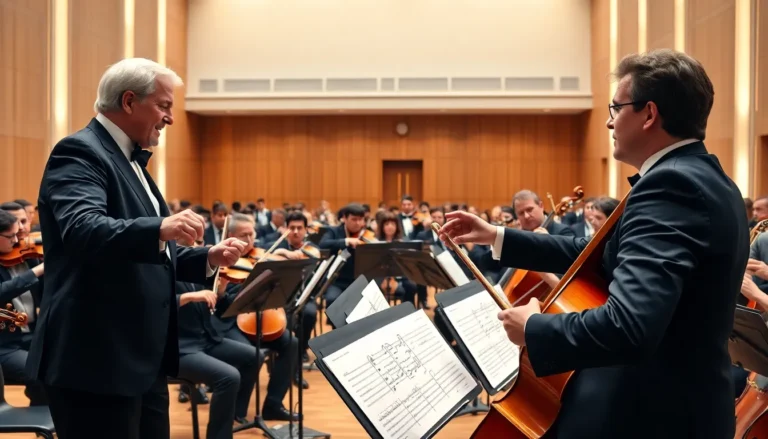Pop music isn’t just a genre; it’s a vibrant tapestry woven from countless styles, each with its own unique flavor. From bubblegum pop that makes you want to dance like nobody’s watching to the sultry sounds of R&B that can make even the most stoic heart skip a beat, the world of pop is a playground for every musical taste.
Table of Contents
ToggleOverview of Pop Music
Pop music encompasses a wide array of genres, reflecting its versatile and broad nature. This genre often blends influences from rock, hip-hop, electronic, and more, creating a unique musical experience. Artists frequently experiment with catchy melodies and relatable lyrics, which resonate with listeners across different age groups.
Bubblegum pop stands out for its upbeat sound and fun themes, catering primarily to younger audiences. R&B, known for its intricate rhythms and emotive storytelling, offers a different perspective, attracting those who appreciate emotional depth in music. Electronic pop combines technology with musical creativity, appealing to fans of contemporary sounds.
In addition, indie pop emphasizes artistic expression and often features eclectic sounds from independent artists. K-pop emerges as a global phenomenon, known for its vibrant aesthetics and engaging choreography, gaining massive popularity outside South Korea.
Moreover, synth-pop uses synthesizers to create a retro yet modern vibe, captivating listeners with its nostalgia. Each subgenre invites distinct elements, allowing pop music to evolve and adapt. The combination of various influences enables pop music to maintain a dynamic presence in the music industry, continually capturing the interest of global audiences.
Through this rich tapestry of styles and sounds, pop music remains one of the most influential genres today, appealing to various musical preferences and cultural backgrounds.
Major Genres of Pop Music
Pop music features a variety of distinct genres, each showcasing unique characteristics. These genres contribute to the genre’s overall appeal and versatility.
Bubblegum Pop
Bubblegum pop targets younger audiences with its catchy melodies and upbeat rhythms. Known for its simple lyrics, this genre emphasizes fun and lightheartedness. Artists often incorporate playful themes in songs, making it accessible and enjoyable for children and teens. Examples include hits from artists like Britney Spears and the Backstreet Boys, who defined this style in the late ’90s.
Dance Pop
Dance pop combines the infectious beats of electronic music with pop sensibilities. This genre often features upbeat tempos and hooks designed to keep listeners on the dancefloor. Artists such as Lady Gaga and Katy Perry exemplify this genre, delivering dynamic performances and catchy anthems. With a focus on energy and club-friendly vibes, dance pop remains a staple in popular music playlists.
Electropop
Electropop integrates electronic elements with pop structure, producing a polished sound. Synthesizers and digital beats dominate this genre, creating a futuristic vibe. Influential artists like Grimes and Zedd push the boundaries of this style, blending innovative sounds with appealing melodies. Electropop’s hybrid nature resonates with various audiences, showcasing its broad appeal in contemporary music.
Indie Pop
Indie pop distinguishes itself through its emphasis on artistic freedom and independent production. Artists in this genre often experiment with diverse sounds, prioritizing originality over commercial success. Acts like Vampire Weekend and Florence + The Machine illustrate the genre’s unique approach, combining eclectic influences with introspective lyrics. Indie pop’s charm lies in its diversity, appealing to listeners seeking something beyond mainstream pop.
Emerging Genres in Pop Music
Emerging genres enrich the landscape of pop music, showcasing innovative sounds and global influences.
Synth-Pop
Synth-pop stands out for its combination of electronic synthesizers and catchy melodies. Originating in the late 1970s and gaining popularity in the 1980s, this genre emphasizes synthetic sounds over traditional instrumentation. Iconic acts like Depeche Mode and New Order defined the genre’s early years. Modern artists such as Grimes and CHVRCHES continue to redefine synth-pop by blending classic elements with contemporary vibes. This evolution creates a fresh sound that resonates with both nostalgic listeners and new fans.
K-Pop
K-pop, or Korean pop music, has rapidly grown into a worldwide sensation. Its vibrant choreography, visually captivating music videos, and diverse musical styles draw a vast audience. Groups like BTS and BLACKPINK showcase the genre’s ability to blend pop with various influences, including hip-hop, R&B, and EDM. The industry’s emphasis on polished production and strong fan engagement has contributed to K-pop’s global appeal. International collaborations further expand K-pop’s reach, inviting millions into its dynamic and colorful world.
The Evolution of Pop Music Genres
Pop music has transformed significantly over the years, incorporating various styles that appeal to different audiences. In the 1960s, the emergence of rock influences reshaped the genre, bringing artists like The Beatles and The Beach Boys into the mainstream. This fusion created a new sound that resonated widely.
During the late 1970s and 1980s, dance pop gained traction, with artists like Madonna and Michael Jackson popularizing upbeat rhythms and catchy hooks. These sounds emphasized production quality and innovation, paving the way for electronic influences that became prominent in the 1990s. The use of synthesizers by acts like Depeche Mode and Pet Shop Boys marked a significant shift in the genre’s direction.
In the early 2000s, a mixture of hip-hop elements began to penetrate the pop landscape. Artists like Britney Spears and Nelly showcased how blending genres could attract broader audiences. R&B’s emotional storytelling gained popularity, with musicians like Usher and Alicia Keys enriching the pop scene through soulful performances.
K-pop emerged from South Korea, captivating global audiences with its high-energy choreography and visually striking music videos. Groups such as BTS and BLACKPINK showcased how cross-cultural influences could redefine pop music on a worldwide stage. The integration of various styles, including hip-hop and EDM, contributed to its rapid rise.
Today, pop music continues to evolve, driven by trends in technology and shifts in listener preferences. New genres like indie pop and electropop emphasize artistic originality and experimentation. Acts such as Lizzo and Billie Eilish reflect this evolution, pushing boundaries and retaining the genre’s broad appeal. Each of these developments reiterates how pop music remains a dynamic force in the music industry.
Pop music’s ever-evolving landscape reflects its ability to adapt and resonate with diverse audiences. From the catchy hooks of bubblegum pop to the intricate rhythms of R&B each genre brings something unique to the table. The rise of K-pop and the innovative sounds of electropop demonstrate how global influences continue to shape this genre.
As technology advances and listener preferences shift pop music will likely keep pushing boundaries. This dynamic nature ensures that pop remains a vibrant and influential force in the music industry. With each new genre and artist pop music will continue to captivate hearts and minds around the world.


